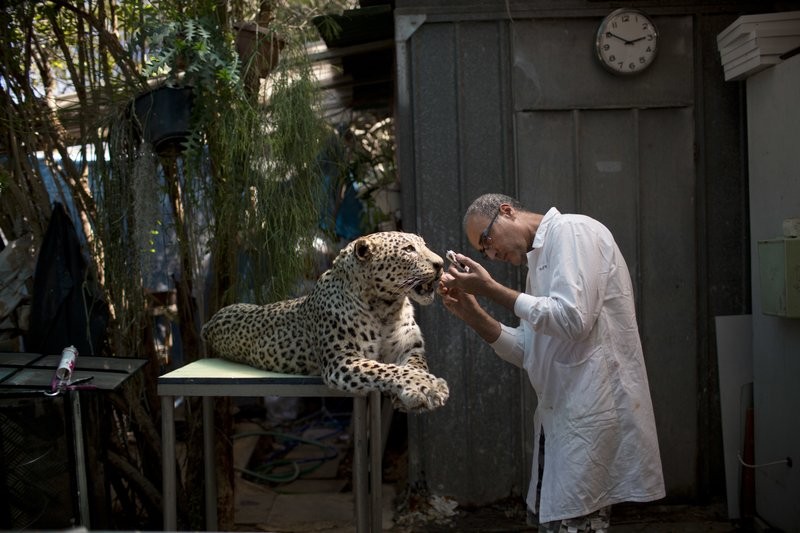TEL AVIV, Israel (AP) — After decades of planning and delays, Israel is opening the doors of a new national natural history museum in the city of Tel Aviv, a facility that aims to increase scientific education despite religious opposition to the theory of evolution.
The ultra-modern ark-shaped edifice is set to open in July alongside the Tel Aviv University campus and houses over 5.5 million specimens of species from around the globe. But the Steinhardt Museum of Natural History places special emphasis on the flora and fauna indigenous to the Holy Land and Middle East. The $40 million project, decades in the making, was funded in large part by American billionaire Michael Steinhardt, a major donor to Israel who keeps a menagerie of exotic animals on his estate north of Manhattan.
The museum’s curators say the institution — ticketed as the only natural history research center in the Middle East — aims to raise public awareness about the natural world and environment by highlighting both the country’s ecological diversity at the crossroads of three continents, and the devastation wrought by modern development.
Its halls combine traditional dioramas and innovative interactive displays to showcase thousands of specimens. Stuffed hawks, pelicans and vultures swirling around the building’s entrance are meant to depict epic avian migrations from Africa to Europe through Israel.
The last Syrian bear to inhabit the country, killed in 1916, and the last Asiatic cheetah, killed in 1911, are ghosts from a lost world, teaching visitors about the devastating changes to the local habitat.
“The main goal of the museum is to bring the public closer to nature,” said Alon Sapan, the museum’s director. “To allow it to feel nature firsthand while supporting this emotional visit with a lot of interesting scientific stories and information, all of which are research-supported … here at the university and this building.”
Behind the scenes are the museum’s labs and research facilities, allowing hundreds of scientists from a variety of disciplines to study the samples of the natural world in the collection. Museum Chair Tamar Dayan said natural history museums play a “key role” in the scientific endeavor to map the web of life and identify, name and study the millions of species on Earth.
“Natural history museums record nature, study nature, and also share their knowledge and treasures with the general public,” Dayan said.
The museum doesn’t shy away from pointing the finger at humanity for its destructive role in the natural world. It places a significant emphasis on anthropogenic climate change and habitat destruction.
But when it comes to human evolution, things are more complicated.
An exhibit on human evolution titled “What makes us human?” looks at humanity’s evolution through the lens of cultural accomplishments: the harnessing of fire, innovation of tools, and development of agriculture. The exhibit is situated on the top floor of the museum, allowing any visitors who may find the subject objectionable to easily bypass it.
“It’s really a sensitive issue in Israel,” said Israel Hershkovitz, a Tel Aviv University anthropology professor who helped curate the exhibit, echoing remarks from other museum officials.
He said there was no intentional decision to hide the exhibit or censor its contents in any way. But he said there also was no intention “to tease the religious” and the out-of-way location was for the best.
“It’s up to everyone whether he wants to see the anthropological exhibition or not. He is not forced to pass through it, it’s the last part of the exhibition, he can go and see it, or if he doesn’t want to see it, he doesn’t have to,” Hershkovitz said.
The Natural History Museum said in a statement that the exhibit’s placement on the top floor was “made within considerations from several angles, which include the museum curation and story plan and the space of each of the museum galleries.”
Orthodox Judaism’s strict interpretation of the Bible leads many to reject the theory of evolution, which is not taught in state-funded ultra-Orthodox institutions, which make up 23 percent of Israel’s schools. Even in non-religious schools, critics point out that relatively few high school students encounter the subject of human evolution in Israeli classrooms.
A small natural history museum in Jerusalem recently came under fire for covering an exhibit about human evolution with a sheet to appease ultra-Orthodox visitors. The museum’s curator defended the decision, saying the religious students otherwise would not have had any exposure to natural history whatsoever.
For many Orthodox Jews, said Rabbi Natan Slifkin, director of the Biblical Museum of Natural History in Beit Shemesh, evolution has become “the thing that in people’s minds defines the lines between the religious and the atheists.”
Although he considers evolution “an adequately proven scientific fact,” Slifkin said his institution decided not to include exhibits about evolution because it would “severely damage our educational mission” of exposing ultra-Orthodox Jews to the natural world.
“Judaism is also connected to crocodiles and hyenas, not just to synagogues and things like that,” he said.




